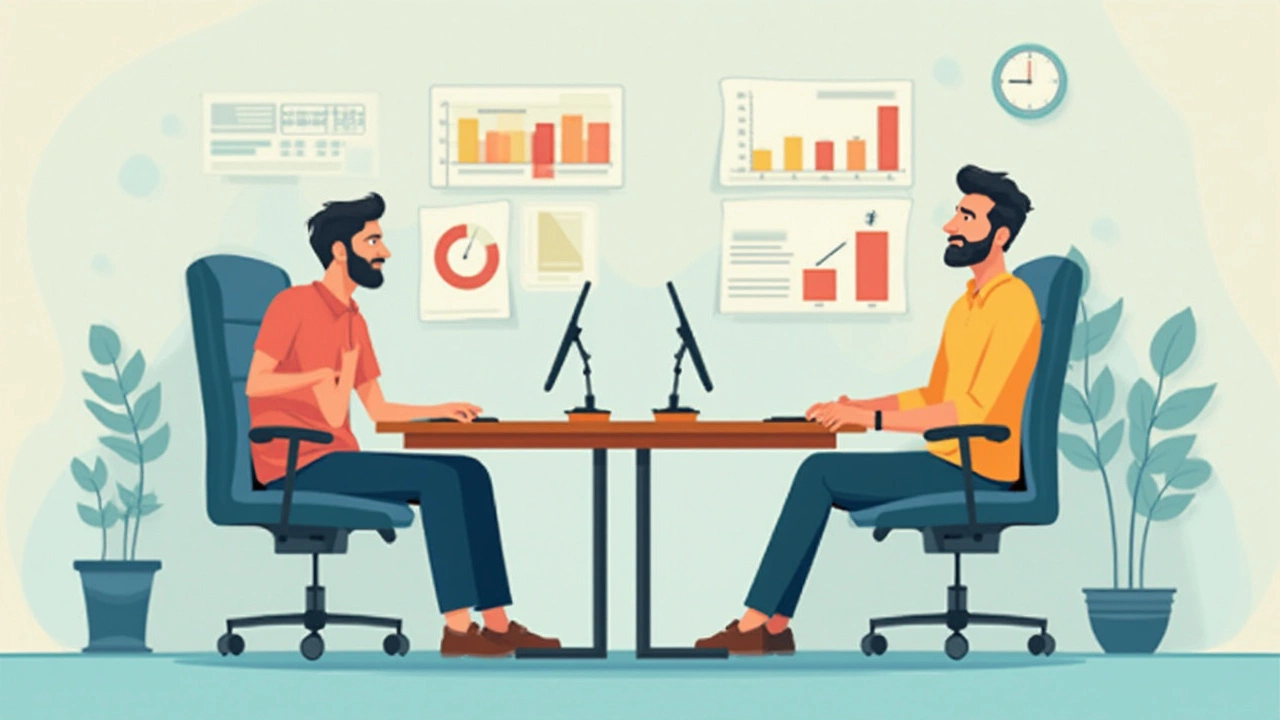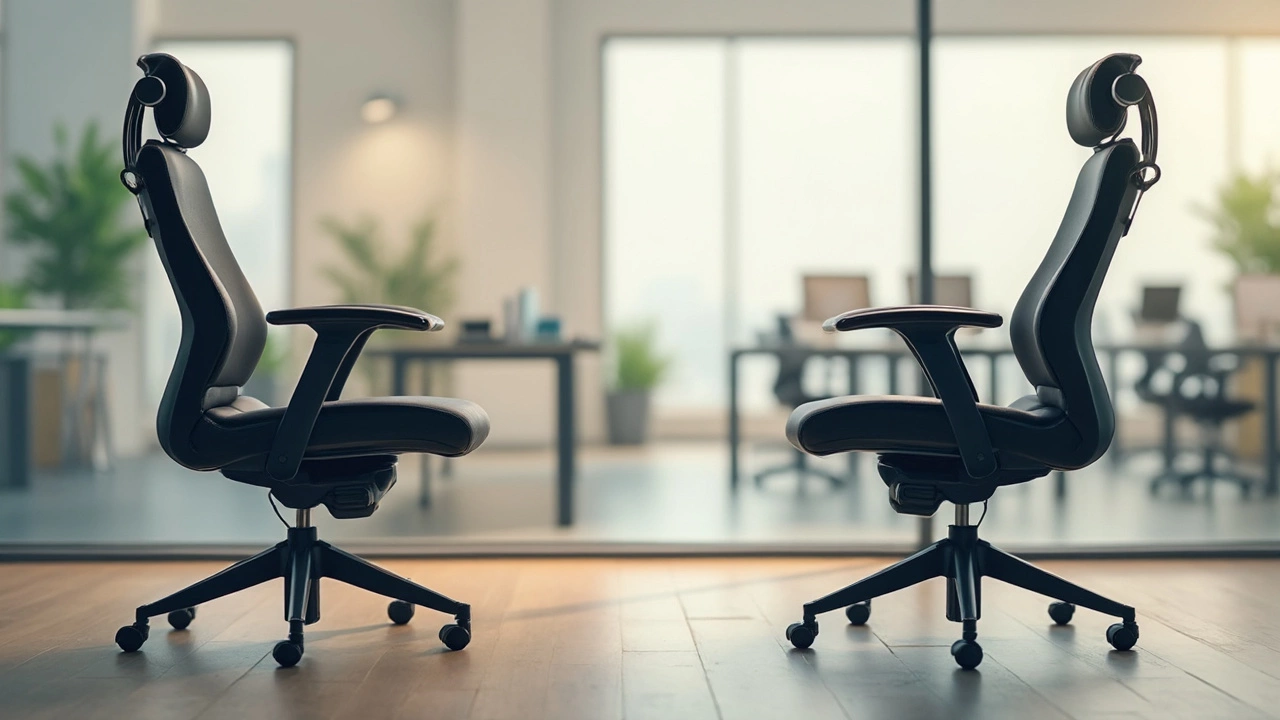Bet you didn’t think the simple act of leaning back in your office chair could spark a debate. But here we are, split between the folks who recline like they're in a La-Z-Boy commercial, and those who sit bolt upright all day. So, what’s actually better for your back, your focus, and your mood?
If your chair can recline, it’s not just a fancy feature—it’s there to help. Sitting straight as a board might look good on camera, but your spine hates it after a while. Research from ergonomics experts shows that a slight recline actually takes pressure off your lower back. Your body was never designed to stay locked at 90 degrees for hours on end. No wonder you feel stiff after a long Zoom call.
- Why Reclining Is Even a Question
- What Happens to Your Body When You Recline
- Proper Recline: Is There a Sweet Spot?
- Common Recline Mistakes (And How to Avoid Them)
- Tips to Make Reclining Actually Work For You
Why Reclining Is Even a Question
So, why even overthink if you should recline your office chair? Turns out, there’s real confusion around how we’re “supposed” to sit at work. For years, the big message was to keep everything at 90 degrees: knees, hips, elbows. And the chair companies? They built most office chairs around that idea.
But newer studies are calling that a myth. For example, a study from the British Journal of Sports Medicine found that sitting upright all day increases pressure on your lower back discs. No wonder back pain rates are so high in office jobs. Here’s a simple breakdown of the differences people experience:
| Seated Position | Back Pressure | Energy Levels |
|---|---|---|
| 90° Upright | High | Declines After 2 Hrs |
| Slight Recline (100°-110°) | Medium | More Stable |
| Deep Recline (120°+) | Lowest | Can Feel Too Relaxed |
The other reason people debate recline? Culture. A lot of us grew up hearing that leaning back looks lazy, or that good posture means military-straight backs. But spinal experts say natural posture actually means a little bit of leaning—it puts your body into the shape it wants, not the one you see in a manual.
Plus, office workers have more adjustable chairs than ever before. With the ability to recline, tilt, and lock, people want to know what all those levers are actually good for. The short answer: most of the time, using your recline office chair feature right is a game changer. But doing it wrong can make things worse.
What Happens to Your Body When You Recline
When you kick that chair back a notch or two, a bunch of things start changing with your body. For starters, reclining lessens the load on your lower back. When you’re stuck sitting straight up, most of your upper body weight presses onto your lumbar discs. Tip yourself back about 100 to 110 degrees, and that pressure spreads out more naturally along your spine and into your chair. This is why you often feel relief in your back right after leaning back.
Your muscles also get in on the action. When you recline your office chair, your core, shoulders, and neck don’t have to work so hard to keep you upright. Constant upright sitting makes these muscles tense up almost all day. That’s why people who stay upright like statues usually complain about aches or even headaches by the end of the day.
Want some numbers? Check this out—a study out of Canada found that the stress on your lumbar discs is lowest when you recline at 135 degrees, though most people find 100 to 110 degrees to be the sweet spot for both comfort and focus. Here’s a breakdown:
| Chair Angle | Disc Pressure (compared to standing) |
|---|---|
| 90 degrees (straight up) | 150% |
| 100-110 degrees (slightly reclined) | 105-120% |
| 135 degrees (deep recline) | 90% |
Blood flow also gets some help. Sitting too upright for too long can pinch blood vessels and slow circulation to your legs, making your feet tingle or even fall asleep. Reclining opens your hips and gives your legs a better shot at staying awake and comfortable.
- You’ll breathe easier since reclining opens your chest and relaxes your diaphragm.
- Your eyes get a break too. Leaning back can help you avoid staring at your screen too close, which makes digital eye strain less likely.
- A recline office chair offers you more than just a comfy position—it helps your whole body work a bit less hard every day.

Proper Recline: Is There a Sweet Spot?
Sliding the recline lever and chilling way back isn’t exactly what your body needs. There’s actually a proven sweet spot for leaning that takes a load off your back but keeps you productive. Ergonomics researchers have tested a bunch of angles, and the magic number for most people is between 100° and 110°—not fully straight, but nowhere near a beach chair angle either.
Leaning back just a bit relieves pressure in your discs and can help boost blood flow, so you don’t leave work stiff as a board. Check out this quick breakdown:
| Recline Angle | Effect on Back Pressure | Recommended For |
|---|---|---|
| 90° (upright) | High Pressure | Short-term desk tasks |
| 100°–110° (slight recline) | Lower Pressure | All-day desk work |
| 120°+ | Low Pressure, Low Support | Short breaks or calls |
Wondering how to set it up? Here’s what to watch for:
- Your feet should stay flat on the floor. A footrest helps shorter folks.
- Keep your lower back in contact with the chair’s lumbar support. Don’t let gaps form.
- Your screen should tilt with you or be easily adjustable so you’re not craning your neck.
- Armrests need to support your elbows without shrugging your shoulders up.
Messing with these details really pays off. A properly reclined recline office chair can make a three-hour stretch at your desk feel a lot less brutal. Just stick to the “easy lean”—enough to take the edge off, but not so much you forget you’re working.
Common Recline Mistakes (And How to Avoid Them)
Sounds simple, but a lot of people use their recline feature the wrong way without even knowing it. Let’s break down the most common mistakes and show you what to do instead. Trust me—your back will thank you.
- Reclining too far back: Leaning way back might feel relaxing for a minute, but it throws your neck and shoulders out of whack. When your monitor is in front but you’re tilted way behind, your head juts forward and your eyes strain.
Sweet spot? Ergonomics studies point out that an angle between 100° and 110° is safest for your spine during work. - Locking the recline: Some folks lock their chair in a rigid upright or reclined position. That’s not how your body works best. Movement relieves static pressure, so keeping your chair slightly mobile helps blood flow. Chairs with a “synchro-tilt” mechanism, which keeps your feet on the ground as you lean back, are winners here.
- Forgetting arm and foot support: Reclining throws off your posture if your arms dangle or your feet lose contact with the floor. Use your armrests and make sure your feet stay planted. Not sure? Plant your feet flat and rest your elbows lightly—your shoulders will feel less tense.
- Ignoring screen distance: Your head inching forward to see your screen defeats the whole purpose. Standard advice: set your monitor so the top is at eye level and about 20-28 inches away.
Now, if you want to go nerdy with the data, here’s a look at what researchers have found about proper recline:
| Seating Angle | Pressure on Lower Back (disc pressure %) | Recommendation |
|---|---|---|
| 90° (upright) | 100% | Not recommended for long periods |
| 100°-110° (slight recline) | 80%-90% | Best range for regular desk work |
| 125° (deep recline) | 60%-70% | Good for breaks, not constant work |
One last thing to remember: you want to use the recline office chair feature, but keep moving throughout the day. Shift your weight, stretch out, and don’t treat any angle like a permanent spot. That’s really how you stay comfortable and avoid those awful aches after work.

Tips to Make Reclining Actually Work For You
Just having a recline feature on your office chair isn’t enough—you’ve got to use it right. A lot of people either ignore it or go full tilt and end up feeling worse. Here’s how you can actually get some benefit from leaning back while working.
First off, aim for a recline angle between 100 and 120 degrees. According to a study from the British Journal of Sports Medicine, this range helps reduce load on your lower back, which is why you feel less achy. Sitting at 90 degrees puts about 40% more pressure on your spine compared to a solid recline. No need to guess—most ergonomic chairs have a numbered tilt lever or a tension knob for this exact reason.
| Recline Angle | Spinal Pressure (Compared to Upright) | Typical Feeling |
|---|---|---|
| 90° | 100% | Stiff, tight low back |
| 110° | 60% | Relaxed, less cramped |
| 120° | 50% | Loose, no pressure points |
Don’t forget to adjust your screen and keyboard. If you recline but your monitor stays put, you’ll end up craning your neck. Move your screen back so it stays at eye level even when you’re leaning. A wireless keyboard and mouse help, too, because you can pull them closer and keep your wrists from floating in space.
- Recline office chair feature works best when paired with lumbar support. Make sure that curve in your chair actually fits the arch of your back, or use a memory foam cushion if things still feel off.
- Shift positions every 30-45 minutes—even with good recline support, staying in one position for hours isn’t good for anyone.
- If you make a lot of video calls, check your camera angle once you lean back. No one wants to see just your neck or ceiling tiles.
If your chair feels wobbly or squeaky after you recline, it might be time for a tune-up or a new chair. That’s not just for comfort, but for your posture. Modern ergonomic chairs are built to keep you in a healthy position even when you lean back, so if you’re fighting your chair, you aren’t getting the right benefits.
Using these tips can make a huge difference in your daily comfort and how your body feels by the end of the workweek. Small tweaks, like adjusting your monitor or fixing your lumbar support, turn the simple act of reclining into a real upgrade for your health.
